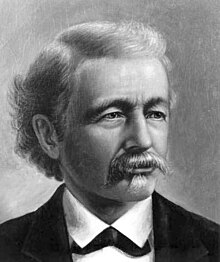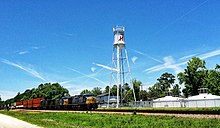| Waycross Short Line | |||
|---|---|---|---|
| Overview | |||
| Status | Still operating | ||
| Owner | Plant System (1881-1902) Atlantic Coast Line Railroad (1902-1967) Seaboard Coast Line Railroad (1967-1986) CSX Transportation (1986-present) | ||
| Termini | |||
| Technical | |||
| Line length | 74.5 mi (119.9 km) | ||
| Track gauge | 1,435 mm (4 ft 8+1⁄2 in) standard gauge | ||
| Electrification | No | ||
| Signalling | Centralized traffic control | ||
| |||
The Waycross Short Line was the unofficial name of a railroad line built by Henry B. Plant that ran from Waycross, Georgia to Jacksonville, Florida on the St. Johns River. The line through Georgia was chartered by Plant as the Waycross and Florida Railroad and the Florida segment was chartered as the East Florida Railway. The line crossed the Georgia/Florida border just south of Folkston, Georgia at the St. Marys River.
History

In 1879, Henry B. Plant acquired what became the Savannah, Florida and Western Railway from its previous owner, the bankrupt Atlantic and Gulf Railroad. The Savannah, Florida and Western Railway (which became the main line of the Plant System) ran from Savannah, Georgia across southern Georgia to Bainbridge via Waycross, Valdosta, and Thomasville. The line already served Florida via a branch line from Lawton (known today as DuPont) south to Live Oak, Florida, which was the first railroad to cross the Georgia/Florida border. While that branch remained important to the Plant System, Henry Plant sought a direct connection of his network to Jacksonville, Florida on the St. Johns River, which would become a major rail junction and shipping port.
In 1880, Plant chartered the Waycross and Florida Railroad as the Georgia segment of the line. It was to run from the main line at Waycross southeast to the St. Marys River (just south of Folkston on the Georgia/Florida Border). Plant then chartered the East Florida Railway as the Florida segment of the line, which continued from the St. Marys River south to Jacksonville via Callahan. Completed in 1881, the Waycross Short Line became the second railroad to cross the Georgia/Florida border. After the line opened, travel time between Savannah, Georgia and Jacksonville was greatly reduced. In 1901, the Plant System built the Folkston Cutoff to further shorten travel between Savannah and Jacksonville.
By 1884, the line was fully integrated into the Plant System. In 1902, the entire Plant System was acquired by the Atlantic Coast Line Railroad. The Waycross Short Line from the Folkston Cutoff south to Jacksonville would become part of the Atlantic Coast Line's main line, which in its entirety would run from Richmond, Virginia to Tampa, Florida. The Atlantic Coast Line would fully expand its main line north of Jacksonville to double track in 1925 along with the installation of automatic block signaling.

The Atlantic Coast Line became the Seaboard Coast Line Railroad in 1967 after merging with their former rival, the Seaboard Air Line Railroad. In 1980, the Seaboard Coast Line's parent company merged with the Chessie System, creating the CSX Corporation. The CSX Corporation initially operated the Chessie and Seaboard Systems separately until 1986, when they were merged into CSX Transportation.
Current conditions
See also: Nahunta Subdivision and Jesup Subdivision
The Waycross Short Line remains in service today and is still operated by CSX Transportation. The segment from the Folkston Cutoff to Jacksonville (which was part of the Atlantic Coast Line main line) is now CSX's A Line (Nahunta Subdivision). From Waycross to Folkston, the line is now part of CSX's Jesup Subdivision. Both Rice Yard in Waycross and Moncrief Yard in Jacksonville remain major freight terminals for CSX.
The segment of the line from Folkston to Callahan, Florida, is sometimes informally known as the Folkston Funnel by rail enthusiasts since nearly all of CSX's traffic from the midwest and the northeast to Florida converge on that segment, which carries roughly 40–45 trains a day. The Folkston Railfan Platform was built in 2001 by the city for viewing trains.
Historic stations
| State | Milepost | City/Location | Station | Connections and notes |
|---|---|---|---|---|
| GA | ANA 587.8 | Waycross | Waycross | junction with: |
| ANA 598.4 | Braganza | |||
| ANA 605.2 | Fort Mudge | Fort Mudge | ||
| ANA 607.8 | Racepond | Race Pond | ||
| Charlton | ||||
| ANA 615.7 | Uptonville | Uptonville | ||
| Homeland | Homeland | |||
| ANA 621.1 A 602.5 |
Folkston | Folkston | junction with Folkston Cutoff (SF&W/ACL) | |
| FL | A 608.5 | Boulogne | Boulogne | |
| A 612.1 | Andrews | |||
| A 614.5 | Hilliard | Hilliard | ||
| A 620.1 | Dyal | Dyal | ||
| A 624.5 | Callahan | Callahan | junction with Florida Railroad (FC&P/SAL) | |
| A 629.5 | Ratliff | |||
| A 635.2 | Jacksonville | Dinsmore | ||
| Pickett | ||||
| A 640.0 | Grand Crossing | junction with: | ||
| A 640.3 | Moncrief | |||
| A 643.7 | Jacksonville | junction with:
|
References
- "When Trains First Came to Central Florida". Tampa Bay Trains. Archived from the original on 1 April 2016. Retrieved 5 October 2020.
- ^ Turner, Gregg (2003). A Short History of Florida Railroads. Arcadia Publishing. ISBN 978-0-7385-2421-4.
- "Waycross & Florida Railroad". Georgia's Railroad History & Heritage. Retrieved 22 September 2018.
- "CSX Florida Funnel". TrainWeb. Retrieved 22 September 2018.
- Atlantic Coast Line Railroad Southern Division Timetable (1949)
- CSX Transportation (January 1, 2005). "CSX Jacksonville Division Timetable" (PDF). Multimodal Ways.
- "Georgia Railroads: Passenger Stations & Stops" (PDF). Jim Fergusson's Railway and Tramway Station Lists (Georgia). Retrieved 5 June 2020.
- "Florida Railroads: Passenger Stations & Stops" (PDF). Jim Fergusson's Railway and Tramway Station Lists (Florida). Retrieved 5 June 2020.